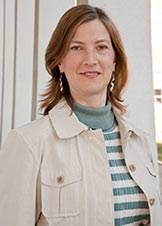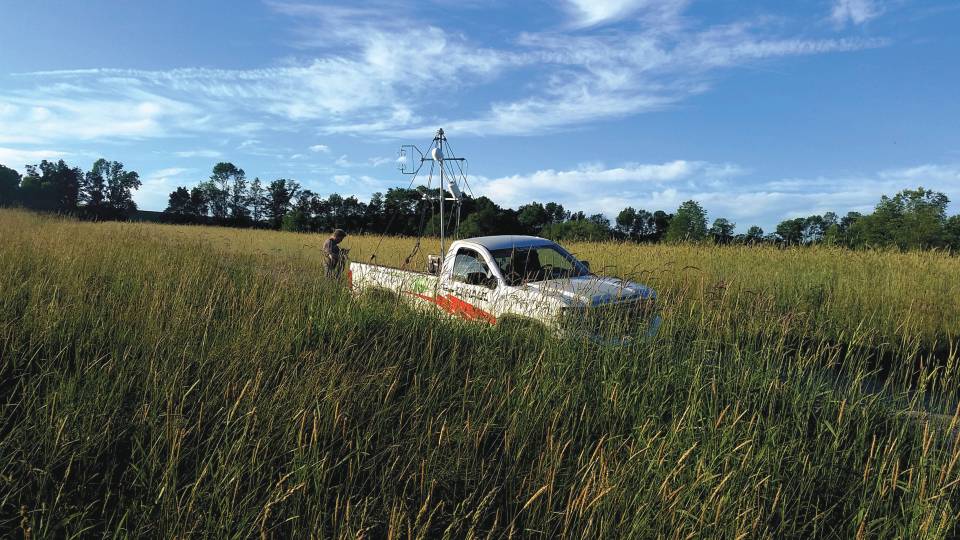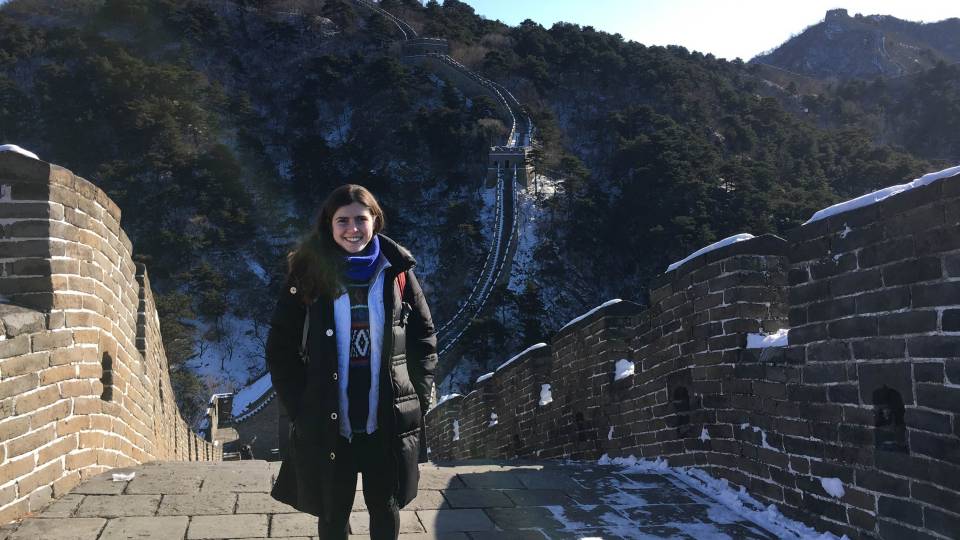To understand why Himalayan glaciers are melting, Princeton Professor Denise Mauzerall looks for causes as far away as Europe and Africa.
In her research and teaching, Mauzerall employs both scientific and regulatory perspectives in analyzing the effects of air pollution on climate change, human health and agricultural production. She has emerged as a leader in efforts to track the flow of pollution through atmospheric models, helping to identify where reductions of harmful emissions would have the largest benefit.
"Our work is trying to inform policy decisions going forward so people can be more strategic about regulatory choices," said Mauzerall, an associate professor of civil and environmental engineering, and public and international affairs.
She has presented her work on air quality and climate change in congressional briefings and at numerous conferences in Asia, where much of her research is focused. She also has contributed to the Intergovernmental Panel on Climate Change, which was awarded the Nobel Peace Prize in 2007 for its efforts to raise awareness about the causes of man-made climate change and ways to counteract it.
Her work brings a new approach to examining links between climate change and air pollution, said Princeton geoscientist Michael Oppenheimer.
"Denise is one of the world's leaders in applying state-of-the-art chemical transport models to important questions in the policy arena," said Oppenheimer, the Albert G. Milbank Professor of Geosciences and International Affairs, and director of the Program in Science, Technology and Environmental Policy (STEP), in which Mauzerall also serves as a faculty member.
"There's a general notion that if you can reduce air pollution and greenhouse gases together the world would be better off. Her work provides the beef backing up that assertion," Oppenheimer said.
Taking a new approach
Mauzerall, who holds degrees in chemistry and environmental engineering, worked in environmental consulting and at the U.S. Environmental Protection Agency before joining the University in 1999. Upon arriving at Princeton, Mauzerall became head of the STEP program in the Woodrow Wilson School of Public and International Affairs, and now directs its doctoral program. She used the transition to academia to rethink her approach to research.
"The STEP program is unique because its faculty members are all Ph.D. scientists but we're sitting in a policy school. We form a bridge between the scientific and policy communities at a time when technical issues are becoming more and more integral to policy decision-making. It’s a critical niche -- I don't know of any other place like it," Mauzerall said.
Mauzerall had worked with atmospheric chemistry models, and aircraft and satellite data, as a graduate student and postdoctoral researcher. At Princeton, she began to look at present and potential consequences of air pollution on health and agriculture and policy mechanisms to address them.
For instance, Mauzerall's research team has used atmospheric models to compute the levels of ground-level ozone, which is known to reduce agricultural yields and have an adverse impact on human health. In one study the researchers calculated surface ozone in East Asia in 1990 and projected levels for 2020, and studied the impact on yields, finding modest losses in grain production in 1990 but predicting substantial losses in 2020.
Because methane is a gas that produces ozone through normal chemical reactions, lowering the amount of methane in the atmosphere would reduce surface ozone levels and should increase agricultural production and improve public health globally, Mauzerall said. Her research found that a 20 percent reduction in global methane emissions would decrease ozone enough to prevent more than 20,000 premature deaths a year. Also, because methane is a greenhouse gas, its reduction would slow climate change, providing "co-benefits" for both climate and air quality. Mauzerall has found that of all the existing ways to reduce surface ozone concentrations, decreasing methane levels is best for climate.
Given its wide-ranging benefits, methane reduction is a critical issue for scientists and policymakers, Mauzerall said.
"In a world with a global population projected to increase from almost 7 to more than 9 billion people in the next 40 years, increasing yields on land under current cultivation is critical both for feeding a burgeoning population and preserving some land in its natural state to benefit global biodiversity," she said.
"By reducing methane you can have benefits for agriculture and health that typically are not considered in climate negotiations as a motivator, and air pollution regulators, until recently, have not considered reducing methane emissions as part of their arsenal of tools to address surface ozone concentrations," Mauzerall said. "We're trying to bring these two communities closer together."
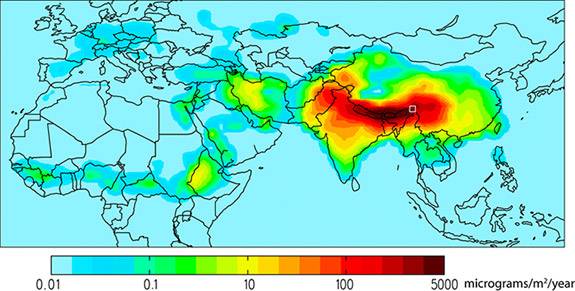
This image shows the source of black carbon deposits on glaciers in the southeast Tibetan Plateau (marked with a white square). Black carbon warms the atmosphere and increases melting rates when deposited on snow. By matching the colors on the image to the scale, researchers can determine the amount of black carbon from a particular region that traveled to the glaciers. (Image: Courtesy of Denise Mauzerall/Monika Kopacz)
Similarly, Mauzerall's research team has looked at aerosol particles such as sulfate and black carbon emitted in China and their impact on human health as well as climate. Recent research in her group, in collaboration with the Geophysical Fluid Dynamics Laboratory (GFDL) at Princeton's Forrestal Campus, found that although the vast majority of premature deaths from fine particles emitted in China occur within China, these particles also have an impact on health in countries as far away as Japan and the United States.
Both sulfate and black carbon increase rates of premature death, but sulfate cools the climate while black carbon warms it. Therefore, regulatory controls on specific future emissions from China will have a substantial impact on climate, Mauzerall said. Policymakers armed with this knowledge can potentially improve public health and reduce climate change simultaneously.
Mauzerall's research makes use of global chemical transport models to understand how pollutants from a particular location such as a city react in the atmosphere with other pollutants; how they move from the city to the suburbs across continents and oceans; and how they affect human health both near and far from their origin.
For example, because black carbon warms the atmosphere and darkens snow, it contributes significantly to the melting of Himalayan glaciers, which can lead to flooding in the short term and water shortages in the long term as the glaciers shrink. Mauzerall's research group is using models to deduce the sources of black carbon arriving in the Himalayas, helping policymakers target potential emissions reductions in the source regions.
"We're able to see that although emissions from India and China are the largest sources of black carbon reaching the Himalayan glaciers, biomass burning in Africa affects the Himalayan glaciers, as well as pollution from Europe and the Middle East," Mauzerall said.
Mauzerall's interest in studying the regional effects of emissions has led to collaborations with GFDL scientists, who have developed many of the atmospheric models that Mauzerall uses in her work. Larry Horowitz, a physical scientist at GFDL who has known Mauzerall since they were both doctoral students at Harvard University, said that Mauzerall's input often motivates the researchers to conduct particular studies.
"We recently completed a multiyear effort to develop a coupled chemistry-climate model. This new tool will allow us to study the complex interactions between air pollution and the climate," said Horowitz, who also is a lecturer in geosciences at the University. "Collaborations between our group at GFDL and Denise's group have been very productive in coming up with new ideas for research and executing those ideas."
Mauzerall also is strengthening ties across the University with her joint appointment in the Wilson School and engineering, said Michael Celia, chair of the civil and environmental engineering department. The department historically has focused on water, and Mauzerall serves as a senior researcher in the department's increasing work on atmospheric processes.
"It's an area that we're building within the department, and she brings the perfect complementary strengths to that group," Celia said.
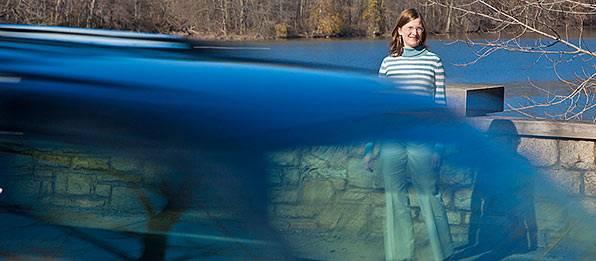
Mauzerall's work with atmospheric chemistry models allows her to estimate the flow and cumulative effects of air pollution, such as smog and soot from vehicles, to determine where regulators should focus their efforts. (Photo: Denise Applewhite)
From Clearwater to chemistry
Mauzerall's work is guided by a passion for the environment that was sparked at an early age. She was inspired by her parents, who delighted in the natural world and discussed topics ranging from how plants make oxygen to the benefits of reusing items rather than discarding and replacing them.
Mauzerall's parents introduced her to the folk singer Pete Seeger, who arrived each fall in her hometown of Dobbs Ferry, N.Y., on the Clearwater sloop, the flagship of an environmental organization Seeger founded to help clean up the Hudson River. He would sing songs such as "Garbage" and "Sailing Up, Sailing Down" in small concerts in a park by the river. Sitting at his feet, Mauzerall resolved to help clean up the environment.
At Brown University she majored in chemistry, then worked as an environmental consultant after graduation to better understand how government and the private sector could work together to address environmental problems.
"My parents are both scientists and they made me realize that understanding how the science worked was critical to figuring out the solution" to environmental problems, Mauzerall said. But her parents "were powerless, as people who worked on the research side, to implement the solutions. I always wanted to go beyond doing basic research to figure out how to apply science to environmental policymaking in order to really solve environmental problems. I debated whether to continue in science, go to law school or make a career in Washington, D.C."
For more than a decade after college, Mauzerall alternated between consulting, research, policymaking and attending graduate school. In addition to working as a consultant and at the EPA, she earned a master's degree in environmental engineering at Stanford University; received her Ph.D. in atmospheric chemistry from Harvard; and served as a postdoctoral fellow and visiting scientist at the National Center for Atmospheric Research in Boulder, Colo.
Campus as classroom
Now Mauzerall is sharing her inspiration for environmental studies with her Princeton students. This spring she taught two courses on global environmental issues, a freshman seminar and an upper-level course for engineering and policy students.
"I love teaching the undergraduates in particular because they're so eager to learn everything, and they're very open-minded and extraordinarily capable," she said.
Brooks Barron, a rising senior who took the upper-level course, said he valued Mauzerall's range of knowledge and accessibility. As a Wilson School major pursuing a certificate in environmental studies, Barron benefited from the multiple perspectives offered and critical thinking required by the course.
"The class has helped me see and understand the issues in a deeper and more complex way," Barron said.
In the freshman seminar, Mauzerall built the students' science and policy knowledge throughout the semester, helping them see the ways in which environmental issues are related.
She also incorporated her research into class lectures and discussions. In one session on air pollution and health, Mauzerall displayed slides showing that by 2020, ozone concentrations largely due to emissions from China would decrease agricultural production of winter wheat, soybeans and spring corn by 30 percent in that country.
"Everyone focuses a lot of attention these days on climate change and the effect on agricultural yields due to warming and precipitation changes, but air pollution is also a big deal. What do you think could be done about this? Would this worry you if you lived in China?" she asked her 12 students, launching a discussion.
Mauzerall often leads classes in which students research solutions to environmental problems. Recent examples include a graduate workshop on climate mitigation policies for the New Jersey Environmental Protection Agency, with the students' recommendations for caps on greenhouse gas emissions ultimately being written into state law, and also an undergraduate task force on sustainability on campus, in which the students' research was presented to senior University administrators.
Mauzerall also serves on the Princeton Sustainability Committee, a group of faculty, staff and students that works to identify means to improve the University's environmental footprint. The University is taking steps to reduce greenhouse gas emissions and conserve resources such as water, and these efforts increase student awareness, she said.
"The more visible environmental and sustainability issues are on campus, the more open and receptive to those ideas students will be when they become leaders in organizations after graduating from Princeton," Mauzerall said. "I think the University initiatives are really important and valuable, particularly when they are publicized in a way that students can learn from them."
